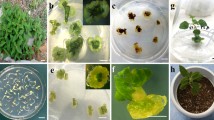Summary
Camptothecin, produced by Camptotheca acuminata, is a pharmaceutically important compound. Transgenic technology has potential uses for the enhancement of camptothecin production; however, an efficient plant regeneration protocol for C. acuminata is not currently available. Factors that affected successful seedling germination were evaluated. The regeneration potential of various parts of seedlings was tested. Camptothecin production in regenerated plants was compared to its production in calluses and the original seedlings. Dark incubation and seed coat removal led to a higher germination rate and a higher survival rate after germination. The best shoot induction medium was found to be Gamborg's B5 medium+8.9 μM benzyladenine. Among the calluses induced from various parts of seedlings, leaf petiole calluses, leaf dise calluses, and cotyledon calluses regenerated shoots, but internode calluses did not. Furthermore, leaf petiole calluses and leaf dise calluses regenerated normal shoots, while cotyledon calluses regenerated hyperhydric shoots. Moreover, leaf petiole calluses had a higher shoot regeneration rate, 50% versus 9%, and a higher shoot number, 6.2±0.5 versus 2.0±0.3, than did leaf dise calluses on the best shoot induction medium. It took 4–6 wk to regenerate shoots after transfer into shoot induction media. Camptothecin concentration in the regenerated plants was significantly higher than that in the calluses and similar to that in the original seedlings. In conclusion, leaf petioles provide efficient plant regeneration of C. acuminata.
Similar content being viewed by others
References
Bonga, J. M. In vitro culture of trees. Boston: Kluwer Academic Publishers: 1992:68–70.
Gamborg, O. L.; Miller, R. A.; Ojima, K. Nutritional requirements of suspension cultures of soybean root cells. Exp. Cell. Res. 50:151–158; 1968.
Gunasekera, S. P.; Badawi, M. M.; Cordell, G. A.; Farnsworth, N. R.; Chitnis, M. Plant anticancer agents X. Isolation of camptothecin and 9-methoxycamptothecin from Ervatamia heyneana. J. Nat. Prod. 42:475–477; 1979.
Jafari, M. A.; Kiss, J.; Gergacz, J.; Heszky, L. E. High efficiency callus induction and plant regeneration in petiole culture of four poplar genotypes. Acta Biol. Hungarica 46:51–59; 1995.
Li, S.; Yi, Y.; Wang, Y.; Zhang, Z.; Beasley, R. S. Camptothecin accumulation and variations in Camptotheca. Planta Med. 68:1010–1016; 2002.
Liu, Z.; Adams, J. C. Camptothecin yield and distribution within Camptotheca acuminata tree cultivated in Louisiana. Can. J. Bot. 74:360–365; 1996.
Liu, Z.; Adams, J. C. Seed source variation in camptothecin concentrations of nursery grown Camptotheca acuminata seedlings. New Forests 16:167–175; 1998.
Liu, Z.; Carpenter, S. B.; Bourgeois, W. J.; Yu, Y.; Constantin, R. J.; Falcon, M. J.; Adams, J. C. Variations in the secondary metabolite camptothecin in relation to tissue age and season in Camptotheca acuminata (Nyssaceae). Tree Physiol. 18:265–270; 1998.
Liu, Z.; Carpenter, S. B.; Constantin, R. J. Alkaloid production in Camptotheca acuminata seedlings in response to shading and flooding. Can. J. Bot. 75:368–373; 1997.
Liu, Z.; Li, Z. Micropropagation of Camptotheca acuminata Decaisne from axillary buds, shoot tips, and seed embryos in a tissue culture system. In Vitro Cell. Dev. Biol. Plant 37:84–88; 2001.
Lloyd, C.; McCown, B. Commercially feasible micropropagation of mountain laurel, Kalmia latifolia, by use of shoot tip culture. Comb. Proc. Int. Plant Prop. Soc. 30:421–427; 1981.
Lopes Cardoso, M. I.; Meijer, A. H.; Hoge, J. H. C. Agrobacterium-mediated transformation of the terpenoid indole alkaloid producing plant species Tabernaemontana pandacaqui. Plant Cell Rep. 17:150–154; 1997.
Lorence, A.; Medina-Bolivar, F.; Nessler, C. L. Camptothecin and 10-hydroxycamptothecin from Camptotheca acuminata hairy roots. Plant Cell Rep. 22:437–441; 2004.
Medina-Bolivar, F.; Wright, R.; Funk, V.; Sentz, D.; Barroso, L.; Wilkins, D. T.; Petri, W.; Cramer, C. L. A non toxic lectin for antigen delivery of plant based mucosal vaccines. Vaccine 21:997–1005; 2003.
Murashige, T.; Skoog, F. A revised medium for rapid growth and bioassays with tobacco tissue cultures. Physiol. Plant. 15:473–497; 1962.
Porobo Dessai, A.; Gosukonda, R. M.; Blay, E.; Korsi Dumenyo, C.; Mcdina-bolivar, F.; Prakaslt, C. S. Plant regeneration of sweet potato (Ipomoea batatas L.) from leaf explants in vitro using a two stage protocol. Sci. Hort. 62:217–221; 1995.
Roja, M.; Heble, M. R. The quinoline alkaloids camptothecin and 9-methoxycamptothecin from tissue cultures and mature trees of Nothapodytes foetida. Phytochemistry 36:65–66; 1994.
Sakato, K.; Tanaka, H.; Mukai, N.; Misawa, M. Isolation and identification of camptothecin from cells of Camptotheca acuminata suspension cultures. Agric. Biol. Chem. 38:217–218; 1974.
Tafur, S.; Nelson, J. D.; DeLong, D. C.; Svoboda, G. H. Antiviral components of Ophiorrhiza mungos: isolation of camptothecin and 10-methoxy camptothecin. Lloydia 39:261–262; 1976.
Tan, W.; Dai, C. Tissue culture technique of ornamental plants. Beijing: Chinese Forestry Press; 1997:201–230.
van Hengel, A. J.; Harkes, M. P.; Wichers, H. J.; Hesselink, P. G. M.; Buitelaar, R. M. Characterization of callus formation and camptothecin production by cell lines of Camptotheca acuminata. Plant Cell Tiss. Organ Cult. 28:11–18; 1992.
Verberne, M. C.; Verpoorte, R.; Bol, J. F.; Mercado Blanco, J.; Linthorst, H. J. M. Overproduction of salicylic acid in plants by bacterial transgenic enhances pathogen resistance. Nat. Biotechnol. 18:779–783; 2000.
Wall, M. E.; Wani, M. C.; Cook, C. E.; Palmer, K. H.; McPhail, A. T.; Sim, G. A. Plant antitumor agents. I. The isolation and structure of camptothecin, a novel alkaloidal leukemia and tumor inhibitor from Camptotheca acuminata. J. Am. Chem. Soc. 88:3888–3890; 1966.
Wiedenfeld, H.; Furmanowa, M.; Roeder, E. Camptothecin and 10-hydroxy camptothecin in callus and plantlets of Camptotheca acuminata. Plant Cell Tiss. Organ Cult. 49:213–218; 1997.
Author information
Authors and Affiliations
Corresponding author
Rights and permissions
About this article
Cite this article
Li, Z., Liu, Z. Plant regeneration from leaf petioles in Camptotheca acuminata . In Vitro Cell.Dev.Biol.-Plant 41, 262–265 (2005). https://doi.org/10.1079/IVP2004631
Received:
Accepted:
Issue Date:
DOI: https://doi.org/10.1079/IVP2004631




